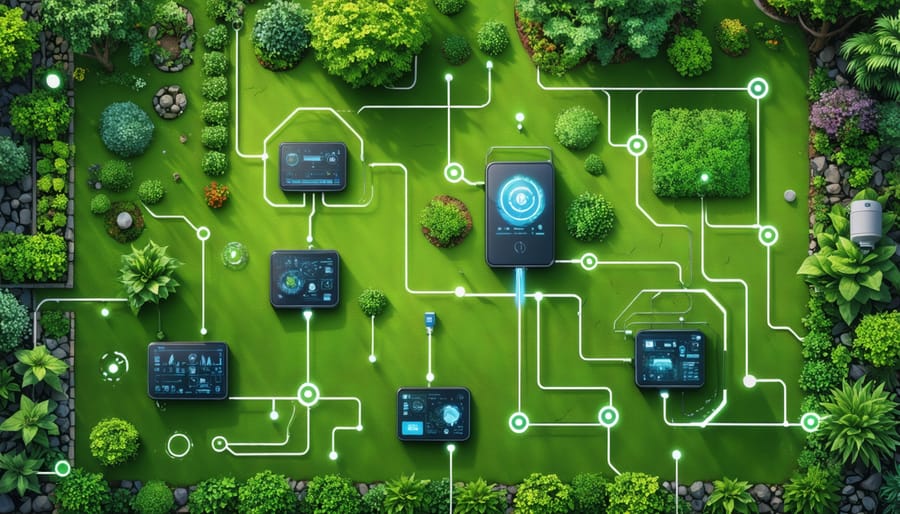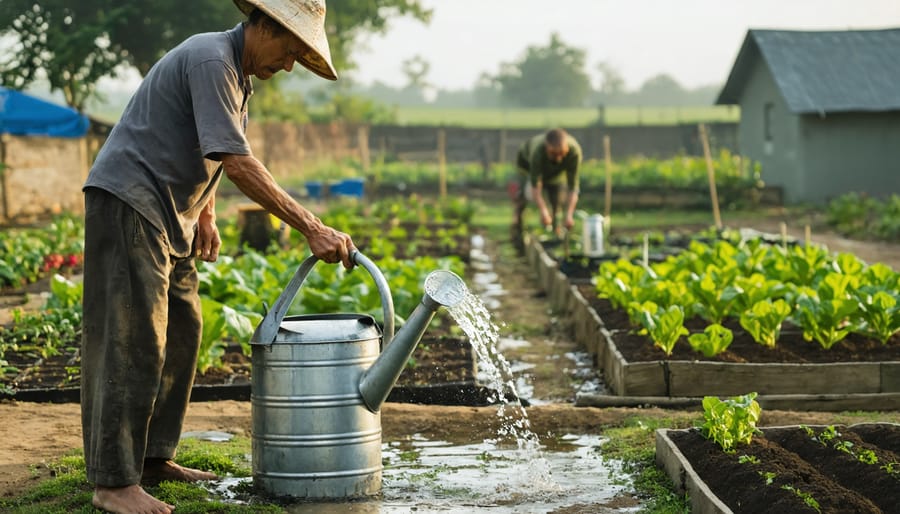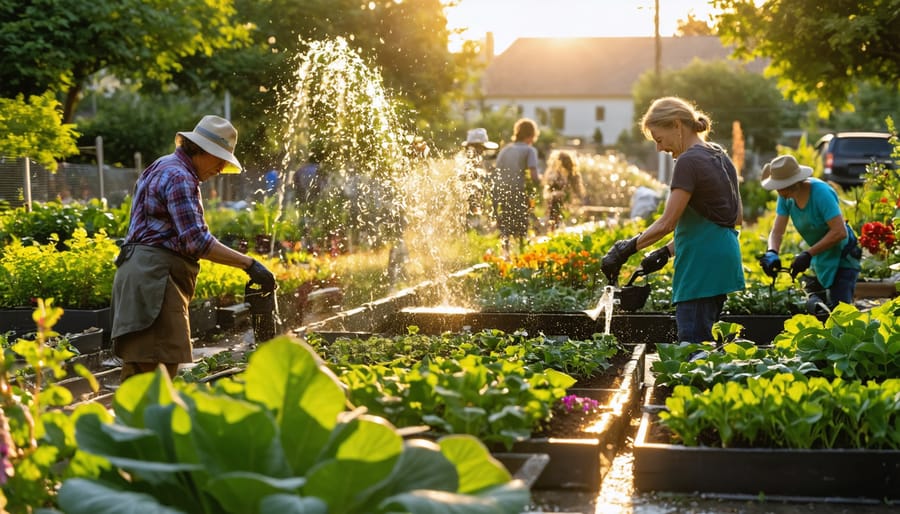Transform your garden’s water management today with smart irrigation systems that reduce water consumption by up to 50% while maximizing plant health. Install rainwater harvesting tanks to capture free, nutrient-rich water that naturally balances soil pH and promotes robust root growth. Integrate soil moisture sensors throughout your garden beds to deliver precise amounts of water exactly when plants need it, eliminating both waste and underwatering concerns. Modern water treatment innovations now make it possible to safely reuse household greywater for garden irrigation, creating a sustainable cycle that benefits both your wallet and the environment. These breakthrough technologies aren’t just changing how we water our gardens – they’re revolutionizing the way we think about water conservation while helping home gardeners achieve lusher, more vibrant landscapes with less effort and expense.
How Remote Sensors Are Changing Garden Water Management
Soil Moisture Sensors: Your Garden’s New Best Friend
Gone are the days of guessing whether your plants need water! Soil moisture sensors are revolutionizing the way we care for our gardens by taking the guesswork out of watering. These smart devices act like tiny underground detectives, constantly monitoring the moisture levels in your soil and letting you know exactly when your plants are thirsty.
These handy sensors work by measuring the electrical conductivity or resistance in the soil – the more water present, the better the soil conducts electricity. Most modern sensors connect to your smartphone through an app, sending real-time alerts when your plants need attention. Some even integrate with automatic watering systems, making garden care practically hands-free!
The benefits are impressive: you’ll save water by watering only when necessary, prevent both under- and over-watering (which can be just as harmful to plants), and create healthier growing conditions for your garden. Many gardeners report using up to 30% less water after installing these sensors.
Installing a soil moisture sensor is surprisingly simple – just insert the probe into the soil near your plants’ root zones, and you’re ready to start monitoring. It’s like having a 24/7 garden assistant keeping watch over your precious plants!

Weather Stations: Making Smart Watering Decisions
Personal weather stations have revolutionized the way we approach garden watering, taking the guesswork out of when and how much to water. These smart devices monitor local conditions like rainfall, humidity, temperature, and wind speed right in your garden, providing real-time data that helps you make informed decisions about your watering schedule.
Unlike relying on regional weather forecasts, your personal station delivers precise measurements for your specific location. This accuracy is crucial because conditions can vary significantly even within short distances. For example, your garden might receive different rainfall amounts than a weather station just a few miles away.
Many modern weather stations connect to smartphone apps, sending alerts when conditions suggest your garden needs water. They can also track historical data, helping you understand seasonal patterns and adjust your watering routine accordingly. Some advanced models even integrate with automated irrigation systems, automatically adjusting watering schedules based on current conditions and forecasts.
By using a weather station, you’ll not only conserve water but also create healthier growing conditions for your plants, as proper watering timing helps prevent common issues like fungal diseases and root rot.

Smart Water Treatment Solutions for Home Gardens
Automated pH and Nutrient Management
Gone are the days of manual water testing and adjustments! Modern gardening has embraced smart technology to take the guesswork out of maintaining perfect water conditions. These automated systems use sophisticated sensors to continuously monitor pH levels, nutrient concentrations, and other vital water parameters in real-time.
Think of these systems as your garden’s personal chemist – they constantly analyze your water quality and make precise adjustments automatically. When the pH drifts too high or low, the system releases the exact amount of pH balancer needed. Similarly, if nutrient levels drop, automated dosing pumps add just the right amount of fertilizer to keep your plants happy.
The heart of these systems is a digital controller that connects to various probes and sensors. Most modern units come with user-friendly interfaces and smartphone connectivity, allowing you to monitor your water quality from anywhere. You’ll receive instant alerts if anything needs attention, and many systems even track historical data to help you spot trends and optimize your water management.
For those just starting out, basic automated pH controllers are a great entry point. More advanced gardeners might want to invest in comprehensive systems that monitor multiple parameters. The initial setup requires some learning, but once calibrated, these systems save countless hours of manual testing and adjusting while providing more consistent results than traditional methods.
Smart Filtration Systems
Modern gardening has embraced smart technology, and filtration systems are no exception. These innovative systems combine traditional filtering methods with cutting-edge sensors to deliver cleaner, more efficient water-saving solutions for your garden.
Today’s smart filters use sensors to monitor water quality in real-time, adjusting filtration levels automatically based on current conditions. Imagine having a system that can detect when your water has higher sediment levels after rain and automatically increases filtration strength – that’s exactly what these smart systems do!
For home gardeners, these systems typically include three key components: physical filters for removing debris, smart sensors for monitoring water quality, and a control hub that you can access through your smartphone. The sensors track factors like pH levels, mineral content, and potential contaminants, giving you complete visibility into your water quality.
What makes these systems particularly appealing is their ability to learn and adapt. They can recognize patterns in your water usage and quality, making preventive adjustments before issues arise. Plus, many systems now integrate with weather forecasts to optimize filtration based on upcoming conditions.
The best part? These systems actually help reduce water waste by ensuring you’re using only the filtration needed at any given time. While the initial setup might seem daunting, most modern systems are designed with user-friendly interfaces that make operation surprisingly simple.
Setting Up Your Smart Water Management System
Choosing the Right Sensors
Selecting the right sensors for your garden is crucial for achieving efficient garden watering techniques and optimal plant health. Start by considering your garden’s specific needs – different plants have varying moisture requirements, and your soil type plays a significant role in water retention.
For smaller gardens or container plants, simple moisture probes work well. These affordable sensors give you a quick reading of soil moisture levels when inserted into the ground. For medium-sized gardens, consider wireless soil moisture sensors that can monitor multiple zones and send data to your smartphone.
Larger gardens benefit from more sophisticated systems combining soil moisture, temperature, and humidity sensors. These comprehensive setups provide detailed information about your garden’s conditions and can automatically adjust watering schedules.
Look for sensors with these key features:
– Weather-resistant construction
– Long battery life
– Easy-to-read displays or app connectivity
– Accurate calibration options
– Multiple sensing depths
Remember that quality matters – while budget-friendly options exist, investing in reliable sensors will save you money and frustration in the long run. Start with one or two sensors to learn how they work, then expand your system as needed.
Installation and Maintenance Tips
Setting up a modern water treatment system doesn’t have to be complicated. Start by identifying your garden’s specific needs and water quality issues. Test your water source to determine which treatments will be most beneficial for your plants.
For basic filtration systems, begin by connecting the main water line to your filter housing. Ensure all fittings are tight and secure to prevent leaks. If you’re installing a UV purification system, mount it in a sheltered location away from direct sunlight and connect it after your primary filter.
Regular maintenance is key to keeping your system running efficiently. Mark your calendar for monthly filter checks and cleanings. Replace filter cartridges every 3-6 months, depending on usage and water quality. UV bulbs typically need replacement annually, even if they appear to be working.
Keep an eye out for any changes in water pressure or quality, as these can indicate maintenance needs. Clean spray nozzles and emitters regularly to prevent mineral buildup. During winter months, protect your system from freezing by draining all components and using insulation where necessary.
Remember to maintain a maintenance log to track filter changes and system checks. This helps you stay on top of routine care and identify any recurring issues early on.

Real Garden Success Stories
Meet Sarah Thompson, a suburban gardener from Colorado who revolutionized her water management using smart soil sensors. “Before installing remote sensors, I was either overwatering or underwatering my vegetable garden. Now, I get notifications right on my phone when my tomatoes need attention,” she shares. Sarah’s water usage dropped by 40% in the first season, and her harvest doubled.
In Portland, community garden coordinator James Chen implemented a network of wireless moisture sensors across 20 plots. “Our gardeners can check soil conditions through an app, making informed decisions about when to water,” he explains. The system helped the community save thousands of gallons while improving crop yields.
Master gardener Maria Rodriguez from Arizona transformed her desert garden using solar-powered sensors. “The technology monitors soil moisture at different depths, helping me understand how water moves through our sandy soil,” she says. Her desert-adapted plants now thrive with 60% less water than traditional irrigation methods would use.
In Seattle’s rainy climate, urban farmer Pete Wilson uses sensors to prevent root rot in his greenhouse. “The sensors alert me when moisture levels get too high, so I can adjust ventilation accordingly,” he notes. His success rate with sensitive herbs has increased significantly since adopting this technology.
These gardeners prove that remote sensing isn’t just for large-scale agriculture – it’s transforming backyard gardens into more sustainable, productive spaces.
As we’ve explored together, innovations in water treatment are revolutionizing how we care for our gardens and manage our water resources. From smart irrigation systems to water recycling solutions, these advancements not only help us save money but also contribute to a more sustainable future for our gardens. By embracing these technologies, you can reduce your water consumption while maintaining a thriving garden that you’ll be proud of. Remember, every drop counts, and implementing even small changes in your water management approach can make a significant difference. Whether you’re starting with a simple rain sensor or diving into a complete smart irrigation system, the future of gardening is here – and it’s more efficient and environmentally friendly than ever. Let’s be part of this positive change and make smart water management a cornerstone of our gardening practice.




